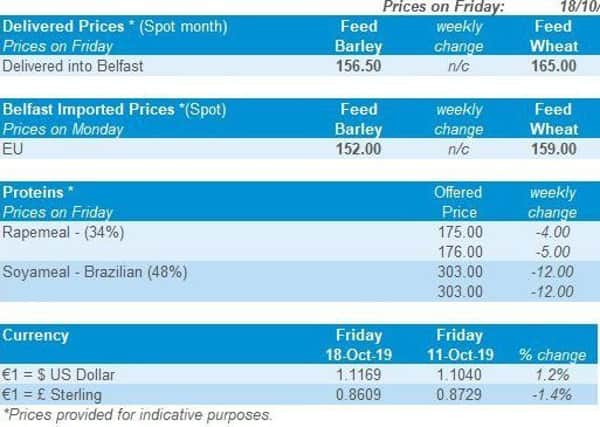Northern Ireland Weekly Market Report


Grains
Wheat - Global supplies remain less than initially forecast for 2019/20. Adverse weather in both the northern and southern hemisphere has added to production concerns.
Maize - Both US and South American crop concerns continue over adverse weather. Parts of South America received some rain last week temporarily alleviating dryness. Further rainfall is forecast this week.
Advertisement
Advertisement
Barley - With the need to export significant volumes of barley and no apparent progress with Brexit, prices will continue to be pressured domestically in order to compete against wheat.
Global Markets - US wheat futures (Dec-19) jumped $8.91/t over the week to close Friday at $195.57/t. Fridays close is the highest price since mid-July. The USDA export data released on Thursday, for week ending 10 October, showed accumulated wheat exports were up 27% from last year. Moreover, 39% of last year’s total volume has already been exported this marketing year.
US maize on the other hand, saw less movement over the week and closed Friday at $153.94/t, down $2.66/t. Although weather has been hindering harvest of both wheat and maize, more favourable weather is in the forecast.
In the southern hemisphere, dryness concerns have been prominent. However, rainfall experienced in South America last week has partially improved soil moistures. Argentinian soil moisture conditions for both wheat and maize are better than last year, at 67% and 62% are deemed favourable to optimum respectively. compared to 48% and 49% last year.
Advertisement
Advertisement
Australia remains dry and production forecasts have been cut in kind.
UK Focus
Large cereal crops in the UK will continue to pressure domestic markets but any further downgrades to global wheat production could offer support. Brexit uncertainty also continues to add trade complexity with no development over the weekend. UK wheat futures moved within a £3.40/t range last week but from Friday to Friday gained just £0.15/t to close at £135.90/t.
Delivered feed and bread wheat prices fell for most destinations and delivery months. With a lack of export trade post-October and ports reportedly full, trade seems to be on a spot basis for top ups to mills and merchants.
Ex-farm prices are available on the AHDB website.
Oilseeds
Rapeseed - Despite currency movements bringing down UK delivered rapeseed prices, the outlook for rapeseed supply remains tight. Black sea imports are expected to continue until the end of the calendar year.
Advertisement
Advertisement
Soyabeans - The continued presence of Brazilian soyabeans in Chinese imports will pressure US prices. However, uncertainty surrounding US crop conditions and continued dryness in South America provide positive sentiment to markets.
Global Markets - Soyabean markets are currently supported by the recent poor weather that will have negatively affected the US soyabean crop.
Following the announcement of a ‘phase-one’ deal between the US and China, markets gained on positive sentiment. However, there have reportedly been no purchases of US-origin soyabeans since the announcement.
Over the course of last week, China booked 480Kt of Brazilian origin soyabeans. Chinese purchases of South American supply are unusual for this time of year, given the ongoing harvest of US soyabeans. The US soyabean harvest was 23% behind the five year average by w/e 13 October.
Rapeseed Markets
Advertisement
Advertisement
Last week, news of an agreed Brexit deal subject to parliamentary approval gave support to both sterling and euro markets. Currency support pressured rapeseed markets. UK delivered rapeseed fell £12.50/t over the week.
Sterling will be vulnerable to price shifts throughout this week, driven by the direction of Brexit news. This may pressure rapeseed prices further despite the overall tightness in EU rapeseed supply.
A front-loaded Ukrainian export schedule this season is likely to cease towards the end of the calendar year. It is expected that EU import origins will swap to Canadian or Australian supply in the New Year.
In Canada, the Saskatchewan canola harvest continues to track below last year, as of w/e 14 October, 58% had been harvested, well behind the three year average of 80%. Australia remains dry, hampering the development of a canola crop already forecast to be 1Mt below the five year average, at 2.3Mt.